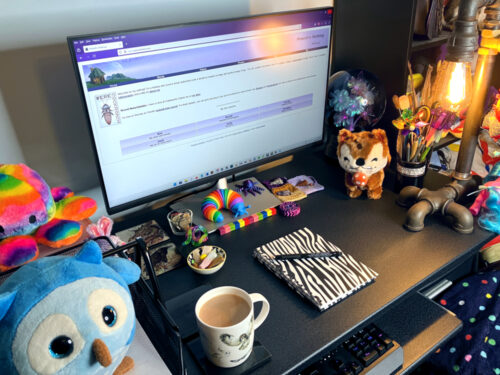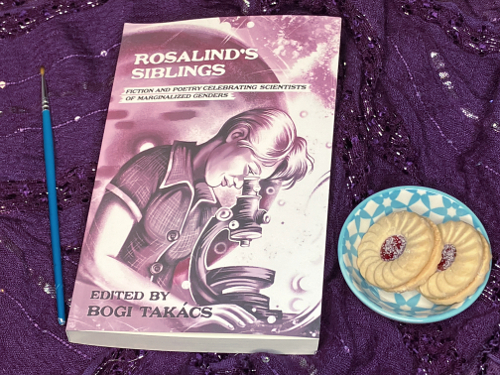I attended Worldcon in Glasgow (2024) as a virtual attendee. That means everything was watched through streaming. I wasn’t physically there. I took detailed handwritten notes, but I also put short summaries on Bluesky. Most panels or talks got one post giving an overview of what was said and an optional second post if there were examples, recommendations or other additional comments.
These are those notes, with some small changes to formatting (like removing hashtags) to work better in a blog post format.
I tended to watch things I thought would inspire stories or result in reading recommendations. I will be watching some of the other panels on replay, but I won’t be doing public notes for those.
Overall, my favourite panel (with multiple people) was Languages of Scotland. My favourite talk (single person) was Fighting Fungi in Space.
It’s time for Worldcon in Glasgow, which I’ll be experiencing from the comfort of my own home. This thread’ll have comments on the panels I watch and stuff. My desk is below, so you can imagine me drinking tea and writing notes in my zebra book.

Image Caption: A black writing desk photo taken at an angle. A keyboard with rainbow lights is on the keyboard shelf and a monitor showing my author website is on the main desk. Other items include various colourful stim toys, plushies, dowsing pendulums, a fiberoptic flower ball, a rusty steampunk lamp, sweets and a mug of tea with owls on it. Work items are pots of pens, pencils, paint brushes and feathers, plus various notebooks. A cuddly owl sits in the in-tray because he hasn’t been processed yet. It’s tidy and free of dust. The bookshelf in the background is not.
This is made possible because I sold a story to Clarkesworld and got paid. It’s about pod people! Read it here!
Story Link: https://clarkesworldmagazine.com/blake_07_24/
Timekeeping on Mars: I have very little concept of time, but here I am! Months named after the zodiac in several systems. Sun dials not very accurate, but still neat. Captions turned the Martian sols (days) into souls. Very goth.
Disability Representation in Middle Grade and YA Fiction: Interesting comments on publishers hiring sensitivity readers and not passing on feedback/allowing time to use it. Not as many SFF examples for younger audiences. One panelist was very unaware and was called out by the audience.
Magnetism – the Force of the Future: Basics of magnets. Social/political issues as rare earth magnets mostly from one place. Some current/future tech. I like the space cannon that fires satellites into orbit!
Dinner break time for me, but the streaming has worked fine so far. Can’t always hear audience questions though (and neither can the autocaption system), so it helps if the speaker answers in a way that sums up the question.
Languages of Scotland: Mainly talking Gaelic and Scots. Languages reflect migration history. Fiction using Gaelic as magic words and Scots to signify poor/working class is not ideal. Importance of modern writing in languages and more respectful handling in fiction.
Autocaptions was faced with languages that sounded close enough to English, so decided to give it a go. The highlight was “come in to the body of the Kirk” which was on theme at least.
More seriously, a lot of similarities to what happened with the Sussex dialect.
I’m now watching the Morrow’s Isle opera, which’ll be the last thing I watch tonight. I can’t really explain what’s going on, but there are dancing rabbits. 🐰
Interview: Wole Talabi interviews guest of honour Nnedi Okorafor. They discuss how she got into writing, common story themes and africanfuturism. A novella series and metafiction novel are upcoming. As a publisher, she’s looking for people doing something weird.
Nnedi mentioned this blog post: http://nnedi.blogspot.com/2019/10/africanfuturism-defined.html
Writing Diasporas in SFF: Being from a diaspora means pressure to be authentic, get it right. But can also be a trap, as trying to represent a whole culture is impossible. Even stories not directly about it often have themes of alienation / outsiders when written by diaspora writers.
Diaspora recommendations (that I managed to catch, I might have missed some) were Salman Rushdie’s early novels, “Speculative Fiction for Dreamers” anthology and “Letters to a Writer of Color” essay collection.
Fighting Fungi in Space: Fungi are everywhere! They’ve caused equipment failures on ISS (eating plastic/rubber) and killed plants. Solutions can’t kill all fungi, as humans need them on their skin. Mainly looking at resistant materials, such as synthetic diamond coating.
“Entangled Life” by Merlin Sheldrake was recommended for learning more about fungi. 🍄
Worldcon Philharmonic Orchestra: A classical music concert. The orchestra was joined by a singer and piper for some pieces. Themes were science fiction, fantasy, games and Scotland. The streamed version was good, so worth watching on replay if you’re a member and missed it.
Neurodivergent Approaches to Stories: Writing helps explore own identity. Characters often have neurodivergent traits even if unintended. Reading helps understand neurotypical people, see self in books, feel part of found families. Need to be flexible about writing advice/rules. Stay weird.
A non-fiction book recommendation was “Care Work: Dreaming Disability Justice” by Leah Lakshmi Piepzna-Samarasinha. Thanks to the Discord chat for figuring out which book was meant.
The Many Legs of SF: Creepy Crawlies in Space: Often seen as the villains. Aspects in non-buglike aliens, like the Borg hive. Empathy with the alien other in making them the protagonists. Transformation themes. Sometimes not that deep: they’re cool and we’re used to having them around.
Authors mentioned include Kafka, Victor Pelevin, Adam Roberts, Octavia Butler, Tiptree, and the Brothers Čapek. Some examples were Nurgle, Lord of Decay, in Warhammer (flies), xenomorphs in Alien (parasitoid wasps), the Borg (eusocial insects) and Starship Troopers (various).
Through an African Lens: Issues with Western publishers using a quota system. Being pigeonholed into writing certain things. Many stories don’t make it outside Africa. Genre boundaries not as strict. Can be dark due to lived history of writers, but also hope, survival and fun.
Too many recommendations to list them all, but the panelists will be putting together a list (added note: this was placed on the Discord chat). The shared universe – Sauútiverse – mentioned. Also the African Speculative Fiction Database (see link).
Database Link: https://www.africansfs.com/resources/list-of-published-african-sff
Surrealism in Fantasy: From the art movement after World War One. A time when nothing made sense, so veering into dream logic. Explores the weirdness of reality. Often more flexible and freeform. No need to explain why/how things work. Has seen a recent resurgence, often in indie presses.
Authors mentioned included: Jet McDonald, Jeanette Winterson, A. S. King, Vajra Chandrasekera, Anna Kavan, Kelly Link, Amos Tutuola and Leonora Carrington. Some mainstream examples were Tanith Lee’s flat earth series and 2000AD Indigo Prime stories by John Smith.
I was apparently mentioned on the panel The Rise of Cosy Fantasy and Science Fiction but that one isn’t online. The book is Werecockroach, so mid-thread shameless promotion!
Book Link: http://www.polenthblake.com/words/cockroach.html
I’ve also been recognised on the Discord. I am a mix between Mike in Monsters Inc being thrilled to be on the cover of a magazine when someone remembers I exist to, “Oh no, I’ve been perceived.”
Found Family in SFF (Online): Cultural aspects as family is broader than Western nuclear in many places. Found family hierarchy can be more flexible and situational. Can be comforting for marginalised readers. The trope of rugged person drawn slowly into family was a favourite.
Chemistry in SF: The study of materials. Starting with tool making and pigments in the stone age, through alchemy, to modern chemistry. Accurate chemistry is unusual in SFF. Many handwavium elements, such as Cavorite (anti-gravity), coaxium (Star Wars hyperfuel), and scrith (Ringworld).
Highlighted examples were Mary Shelley’s Frankenstein using (real) chemical means to generate electricity, and Isaac Asimov’s “The Endochronic Properties of Resublimated Thiotimoline”, a short story structured as a paper about an element that dissolves before it’s put in water.
The Influence of Scotland on Fantasy Worldbuilding: Landscape in hills, glens, mist, castles… but often neglecting modern. Folktales like kelpies and fairy groves. Exact stories vary between areas. Stereotypes of dwarves, groundskeepers and exaggerated accents not so great.
Mentioned books were T.L. Huchu’s The Library of the Dead series (Scottish writer) and “Castles in Their Bones” by Laura Sebastian (outsider writer who researched). The film “Under the Skin” was guerilla filmed in Glasgow.
30 Years of MYST: Starting with Myst. Followed by Riven, which felt more like a place people lived. There were related novels and there’s a convention called Mysterium. The games have a sense of strangeness and deep lore. Similar vibes to real world backrooms / liminal spaces.
Some games with similar feelings mentioned were Abducted, The Witness, Heaven’s Vault, Quern and the second Talos Principle. For novels, “Piranesi” by Susanna Clarke. The first Myst novel is “The Book of Atrus” by Rand Miller.
Premee Mohamed Reading: Premee reads from “The Butcher of the Forest” using a mic in a mug. Sneaky cat cameo in the back.
Book Link: https://us.macmillan.com/books/9781250881786/thebutcheroftheforest
LitRPG and Progression Fantasy: Progression where problems are solved by getting stronger. LitRPG is a gamified world. Very indie. Little big pub stuff. Audiobooks and serial fiction are popular formats. Many of the book games are broken on purpose and would make terrible actual games.
“Dungeon Crawler Carl” by Matt Dinniman is one that’s become very popular. Royal Road, a web story site, has many examples. (They didn’t mention many specific examples, so I’ll add a rec from me. I enjoyed “Sufficiently Advanced Magic” by Andrew Rowe.)
Fantasy Noir and Other SFFH Mashups (Online): Early noir often had light fantastical elements. Building on that can produce something unexpected. Best tackled from a place of loving all involved genres/tropes. Mashups they’d like to see more: romance and hard science fiction.
A few of the genre mashing authors mentioned: Aliette de Bodard, Wilhelmina Baird, Randall Garrett, Lara Elena Donnelly, Joe Lansdale and Kurt Vonnegut.
(The panel mentioned games, but didn’t give examples. So in my game rec: “The Vanishing of Ethan Carter” is a noir cosmic horror.)
Appropriation Versus Inspiration: Don’t write viewpoint characters outside your culture. Research for non-viewpoint characters. I’d note this doesn’t work for those of us where it’s complicated. For example, an audience member asked how to deal with not being properly in any culture.
My take as someone in that unbelonging category: embrace being an outsider/writing about outsiders and do your best to research the rest. I don’t think people actually intend to sound like us folk shouldn’t write. We just weren’t part of the assumed audience.
Finding Story in the Landscape: Landscape is shaped by people. Layers of story and history. It can be a character in the story, interacting with characters and narrative. The panel would like to see more land as main character and how migration influences land connections.
Writing Future Scotland: Everywhere has a future! Could include themes of Scottish independence and climate change altering landscape. History and present can be explored through the future, such as past colonialism, folklore and the modern/future co-existing, and language changes.
Works mentioned were the anthologies “Gallus” and “Nova Scotia”, “The Library of the Dead” by T.L. Huchu, “Bucket List” by Russell Jones and SF Caledonia (an online magazine).
Magazine Link: https://www.sfcaledonia.scot/
The Impact of Textiles on the Built Environment: The impact is everywhere (like farming, buildings for fabric work, furnishings as class signifiers). In science fiction, hard surfaces are cheaper for TV, but the future would have comfort. Tech/magic fabrics could do amazing things.
This is the last post in my thread of mini summaries of the panels/other stuff I watched at Glasgow Worldcon 2024. It’s also the beginning, because the best way to view a thread is to load the last post (this one) and then scroll back to the beginning. It’s been fun!



